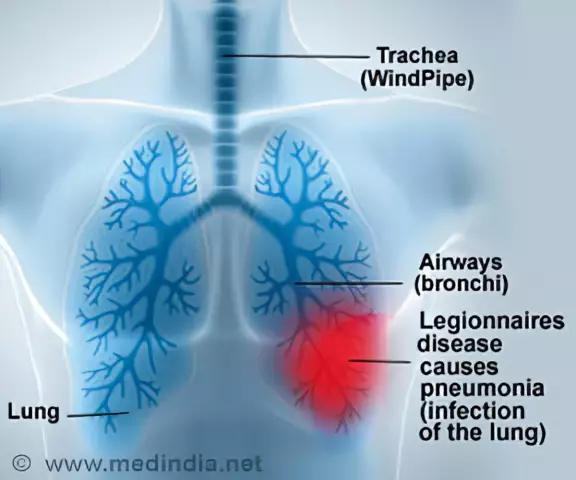- Author Rachel Wainwright [email protected].
- Public 2023-12-15 07:39.
- Last modified 2025-11-02 20:14.
Cardialgia
Overview of pain in the left side of the chest

Pain in the heart (on the left side of the chest) is collectively called cardialgia. Heart pain occurs for a variety of reasons. Many of them are associated with vascular diseases, through which blood and oxygen are delivered to various parts of the heart. In medical practice, it is generally accepted that such pains are potentially life-threatening conditions, since they can be a symptom of angina pectoris, stroke, myocardial infarction and other serious diseases. On the other hand, often the pain syndrome has nothing to do with coronary artery disease. In this case, doctors say that the patient has pure cardialgia, the symptoms of which do not pose a threat to human life.
Causes of cardialgia
- heart disease, excluding vascular lesions;
- inflammatory processes - pericarditis, myocarditis;
- metabolic disorders;
- diseases of the ribs and spine;
- hypertrophy of some parts of the heart;
- osteochondrosis;
- chest trauma;
- diseases of the digestive system
So, as you can see, cardialgia (you will find a description of the symptoms of the disease in our article) can occur for a variety of reasons. It is important to understand that pain in the heart area is not necessarily a harbinger of severe complications, but we also do not advise you to self-medicate. The best option is to contact an experienced cardiologist who will decide why cardialgia has arisen, whether its symptoms pose a threat to the patient and what exactly should be done in order to get rid of the discomfort.
Cardialgia - a description of the symptoms of the disease

As you already understood, any pain in the left side of the chest is considered cardialgia until an accurate diagnosis is made, unless, of course, there is good reason to suspect a heart attack or stroke. Let's talk about the most common causes and symptoms of pain syndromes.
Quite often, cardialgia is a sign of the development of neurocirculatory dystonia. The disease is characterized by prolonged pain, fatigue, and a feeling of defective inhalation. Also, headaches and a constant feeling of anxiety are possible for the most minor reasons. Taking nitroglycerin does not relieve the patient of unpleasant sensations, which is quite natural if this is really cardialgia (the symptoms of the disease are not associated with vasoconstriction, and therefore nitroglycerin will be ineffective).
Pain in the left side of the chest can be caused by osteochondrosis and herniated intervertebral disc. At the same time, the intensity of sensations does not depend in any way on the magnitude of physical exertion, and increases exclusively with certain positions and movements of the hands or head. The most severe pain occurs during sleep, when a person reflexively moves his hands behind his back or spreads them to the sides. Of course, such cardialgia has nothing to do with heart disease, and an orthopedist should eliminate the cause of its occurrence.
The cervicobrachial syndrome causes compression of the subclavian veins and arteries. As a result, a person feels pain in the left side of the body when carrying heavy loads in their hands or when raising their arms up. Also, patients have a decrease in body temperature, swelling of the hands, a decrease in blood pressure. You should not be afraid, because this is again cardialgia, the symptoms of which indicate pathological hypertrophy or the presence of an additional cervical rib.
Often, chest pains are caused by intercostal neuralgia, shingles, or neuroma of the roots. The latter disease leads to the development of such a severe pain syndrome that even morphine does not help patients. This fact, by the way, is indirect evidence for the correct diagnosis.
People over 40 years old very often develop Tietze's syndrome or thickening of the costal cartilage. As in all the cases described above, these diseases are accompanied by cardialgia (a description of the symptoms of the disease makes it easy to identify the real source of pain). Unpleasant sensations disappear when taking ibuprofen, analgin or brufen.
If you are obese, then don't be surprised if you suddenly develop cardialgia. People who lead a sedentary lifestyle will definitely meet with her. As a rule, pain occurs immediately after eating and is often confused with angina pectoris. A competently collected anamnesis will help to make an accurate diagnosis.
The aching and stabbing pains in the left side of the chest are a common companion of pulmonary hypertension, pleurisy, myocarditis and pericarditis. Again, they are often confused with cardialgia, since the nature of the underlying disease allows such a conclusion. Only a complete examination of the patient and the experience of a doctor can help here.
Instead of a conclusion
The feeling of squeezing in the chest is accompanied by menopause in mature women, as well as disorders of the digestive system, trauma, infections and dozens of diseases. In all these cases, a person feels pain in the region of the heart, anxiety, depression and fear. It seems to him that life is over, that his "motor" has worked its way out and needs serious treatment. Don't jump to conclusions! As practice shows, in about 60% of cases, a cardiologist diagnoses cardialgia and sends the patient for consultation to other specialists.
YouTube video related to the article:
The information is generalized and provided for informational purposes only. At the first sign of illness, see your doctor. Self-medication is hazardous to health!






